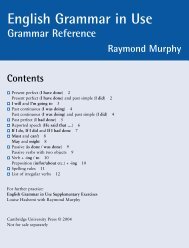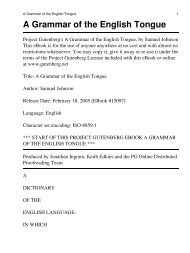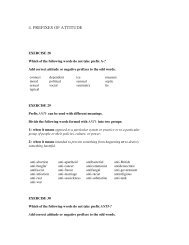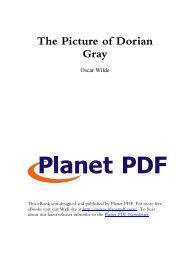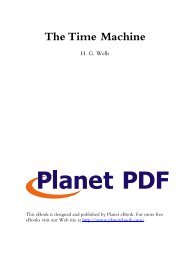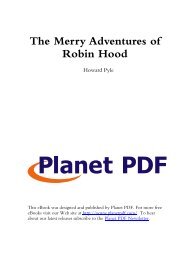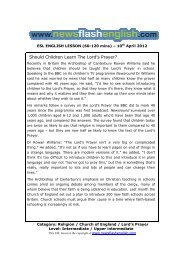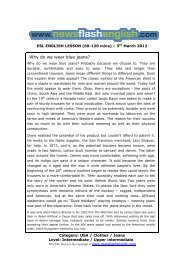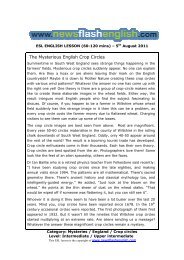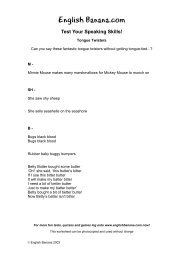TO DOWNLOAD - 75 Pages (928kb - PDF format) - ESL Teachers ...
TO DOWNLOAD - 75 Pages (928kb - PDF format) - ESL Teachers ...
TO DOWNLOAD - 75 Pages (928kb - PDF format) - ESL Teachers ...
Create successful ePaper yourself
Turn your PDF publications into a flip-book with our unique Google optimized e-Paper software.
RHE<strong>TO</strong>RICAL SKILLSCarl Resener categorizes the homeless accordingto the reasons for their displacement: the"Seekers," the "Mentally III," the "Stranded," andthe "Self-inflicted" (29-42).3. By simply referring to the author in the text, omittingparenthetical reference.Leggeff condemns the entire scope ofcontemporary entertainment and amusement asincapable of provoking any educational orintellectual aftermath in the minds of theparticipating American public.MECHANICS OF THE PARENTHETICAL REFERENCEThe great advantage of the MLA method of documentationis that it allows you to document a source briefly andclearly. There are three ways you can insert your referencesto sources in your text:1. Place the author's last name and the page number(s)of the source in parentheses before the final period ofthe sentence containing the citation."Berenice" is seemingly cut from the samepsychological cloth as his acknowledgedmasterpieces, and the reader at once recognizesthe familiar hallmarks of Poe's work, "a somberGothic setting, remote and distant time and locale,a narrative woven of psychological aberrationswhich reflect upon and illuminate the human mind"[Burson 45).2. For clarity, place the reference within the sentence tomake clear its relationship to one part of your statement.While Burson concludes that the popular shortstory "is not a horror story at all, but rather ahumorous and sometimes wildly comiccommentary on the Gothic tale as Poe understoodit" (48), there is no doubt that "Berenice" hasalways been considered a serious tale of horror,3. If you are documenting a quotation of more than fourlines set off from the text, place the reference at theend of the quotation two spaces after the final period.Follow the MLA recommendations for spacing displayedquotations of four or more lines from the bodyof your paper:• Double space before and after the quotation.• Indent ten spaces from the left margin.• Double-space the quoted lines.If the reader is misled by these passages,that is, if he believes that the author is inearnest, he may be relying too much on thelofty style of Poe's language: his elaborateperiodic sentences, the almost oratoricalrhythm of his lines, the layers of descriptionor restatement that lend credence to hisideas, his use of classical names or allusions,his frequent employment of quotationsin other languages, his dramatic expressionslike Alas! or Ah!, his implied superiority overthe reader in facile citations from sophisticatedor occult spheres of knowledge, hisminute distinctions of word or thought thatpretend fine intellect. It is just this style that isbeing parodied, in fact, by the nonsensicalnature of what is being so impressivelydescribed. [Burson 55)MECHANICS OF THE "WORKS CITED" SECTIONThe following examples provide models for frequendycited sources.A Book by One AuthorWylie, Philip. Generation of Vipers. New York:Rinehart, 1942.Two or More Books by One AuthorGrisham, John. The Firm. New York: Bantam,1991.-. A Time to Kill. New York: Bantam, 1989.-. The Pelican Brief. New York: Doubleday, 1992.A Book by Two or Three AuthorsOsborne, David, and Ted Gaebler. ReinventingGovernment: How the Entrepreneurial Spirit IsTransforming the Public Sector, Reading:Addison, 1992.A Book by Four or More AuthorsEhrenhaft, George, et al. How to Prepare for theACT. New York: Barron's, 1991.OREhrenhaft, George, Robert. L. Lehrman, AllanMundsack, and Fred Obrecht, How to Preparefor the ACT. New York: Barron's, 1991.A Book by an Anonymous AuthorThe Key to English: Figurative Expressions. 1968 ed.New York: Macmillan, 1968.A Book with an EditorBucker, William E., ed. Prose of the VictorianPeriod. Boston: Houghton, 1958.




